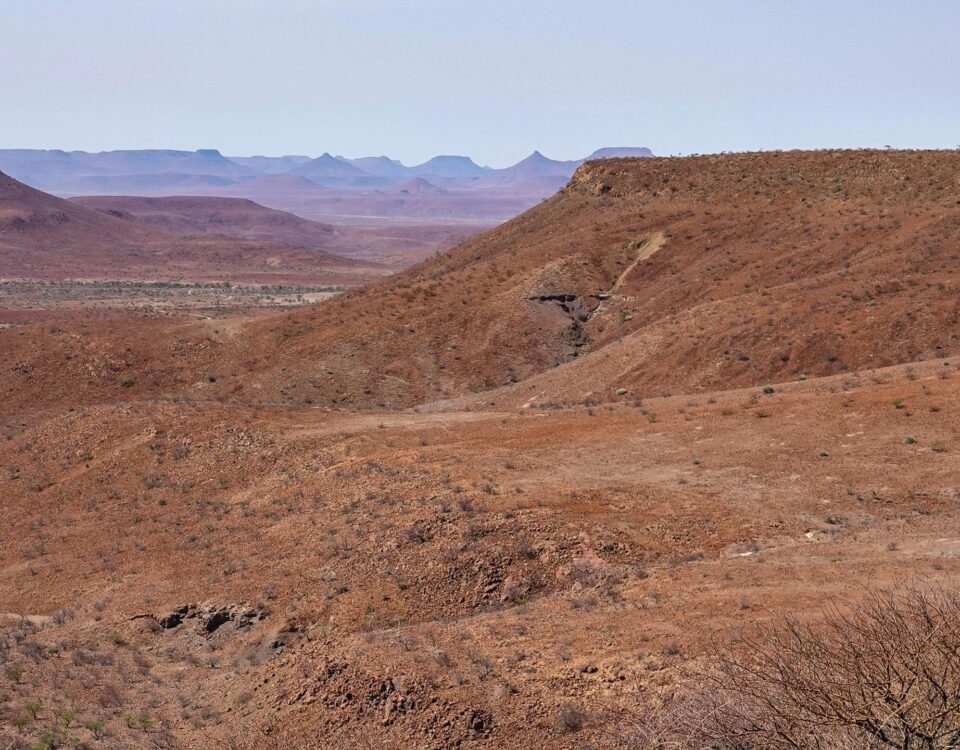Naukluft Experience – In the realm of the mountain zebra
July 18, 2012Okaepe living museum and school project
July 18, 2012by Sven-Eric Kanzler
There is no doubt about it: Naukluft is a fascinating picture book for geologists and laymen with an interest in geology.
And those who find the history of rocks less than thrilling are bound to marvel at the magnificent landscapes, if not immediately, then certainly when they reach Büllsport Guest Farm and discover that it’s not only the coast south of Lüderitz that boasts an imposing Bogenfels. Three guest farms in the area, BüllsPort, Blässkranz and Ababis, recently launched the Naukluft Experience, unveiling a treasure trove of interesting tourist options.
 Naukluft owes its name to the seasonal Tsondab River. Most of its catchment area is situated east of the mountains. During a more humid period the Tsondab or its predecessor(s) cut a gorge through the range from east to west. The only through valley was named by the Afrikaner farmers as ‘nou kloof’ (nou = narrow; kloof = gorge), which became Naukluft during German colonial times.
Naukluft owes its name to the seasonal Tsondab River. Most of its catchment area is situated east of the mountains. During a more humid period the Tsondab or its predecessor(s) cut a gorge through the range from east to west. The only through valley was named by the Afrikaner farmers as ‘nou kloof’ (nou = narrow; kloof = gorge), which became Naukluft during German colonial times.
Small clouds of fine dust are swirling in the beam of light as we push deeper and deeper into the cave. “Mind your heads,” our cave guide, Karsten Schwabe, cautions. The sound of his voice dies away immediately. Even in the large vault, where we shine our torches all over in wonder, there is almost no echo. Then it dawns on us: soft sand covers the ground like a wall-to-wall carpet and muffles every sound. In one of the corners we even find a layer of plant remains. We deduce that lots of water flushed through here at some stage.
We are exploring Märker Cave on Farm Blässkranz in the Naukluft Mountains. This is just one of many caves formed in a process known as carstification, causing these mountains to be riddled with galleries and caverns. The Naukluft consists mainly of limestone and dolomite. When rainwater seeps through the rock, calcite is dissolved in the carbonic acid of the water, and over aeons a subterranean maze has been formed.
On a small scale the dissolution process is evident on many stones found at Naukluft. The mildly acidic rainwater has eaten grooves into them. Because of their structure and grey colour, these stones are aptly referred to as ‘elephant skin’.
Much larger traces of the underground abundance of water can be seen on Blässkranz Guest Farm, where enormous rock formations look like petrified waterfalls. The rugged limestone and dolomite rock can be pictured like a huge sponge that soaks up rainwater and stores it in its depth. The water then seeps down to impermeable layers of an older rock formation and escapes in the form of numerous springs. In some places the calcium carbonate solution is deposited as tufa, or travertine.
With its precipitous shape and light colouring, chalky white in part, travertine stands out among the surrounding darker rock. Two beautiful examples are big and small Blässkopf, visible south of the C 14 road through Naukluft. Farm Blässkranz derives its name from the many examples of ‘blazes’ (Blesse in German) in the area. According to Karsten Schwabe, who runs the guest farm, the tufa formations are the second largest in the world, next to the famous tufa landscape in Turkey.
The Naukluft Mountains are a segment of the great escarpment that forms the western border of the highland in the country’s interior and separates it from the Namib Desert, situated at a much lesser altitude. Geologists, however, do not quite agree on how these mountains formed. It is only considered as relatively certain that Naukluft is a mountain range that shifted into its current position from the north west.
About 525 to 500 million years ago the supercontinent Gondwanaland was formed through the merging of several cratons (primeval continents) as a result of continental drift.
As the Congo and Kalahari cratons slowly collided, their rims crumpled and piled up, pushing on top of one another. This was the birth of the Damara mountain range that once covered large parts of Namibia and became eroded down to its trunk almost everywhere.
Blankets of rock (nappes) shifted on top of one another at the southern end of the mountain range. Under the tremendous pressure and heat, sediments from former salt lakes turned into a gel-like mass, a lubricant that enabled the top nappe to slide further down. In fact, it moved up to 50 km to the south east all in one piece.
The size of Naukluft gives some idea of the gigantic forces at work: it still covers an area of 2 100 square kilometres, just under an eighth of the size of the Kingdom of Swaziland and two and a half times as large as Berlin.
Sources – Nicole Grünert: Namibia Fascination of Geology (2003), Gabi Schneider: The Roadside Geology of Namibia (2004)
This article appeared in the April ‘05 edition of Travel News Namibia.



